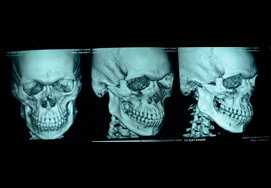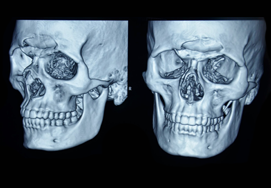Zygomatic Fractures
Suitable for the patients with the conditions like having paresthesia or hyposthesia in upper lip, orbital floor disruption, and displaced fractures

- What is a zygomatic fracture?
- What are the treatment options for cheekbone fractures?
- Approaches used for repair of Zygomatic bone fractures?
- Which individuals are eligible for the surgery?
- How should I prepare for the surgery?
- What is the aftercare of the surgery?
- What are the postsurgical considerations?
What is a zygomatic fracture?
Cheekbone or the zygomatic bone occupies the major aspect of your facial skeleton. The fracture commonly results from a blunt force trauma to the face. An immediate treatment is crucial that may regain your natural facial contour and to provide the support for your eyes. A cheekbone fracture may cause flatness of the cheek, altered sensation under the eye, pain while moving the jaw, pain and severe bruising. If the problem is left unrecognized, it can lead to undesirable cosmetic and functional outcomes.
What are the treatment options for cheekbone fractures?
The treatment of cheek fracture depends on the extent of the damage of underlying structures and the movement from their original locations.
Almost 50% of the zygomatic fractures require no surgical intervention. Your doctor may recommend you a reoconstructive surgery to reposition the facial bone and attach it to the surrounding stable bones. But, if the orbital walls are disrupted, air enters into the retrobulbar space causing pain and visual loss.
Approaches used for repair of Zygomatic bone fractures?
Cheekbone fractures can be repaired by various surgical methods. Your surgeon will choose the type of surgery based on the extent and severity of the fracture.
Closed reduction – used in fractures which are stable after reduction.
Direct cutaneous approach: This is the least invasive surgical approach and performed without a surgical incision. Your surgeon places a bony hook or hemostat or a suture around the arch. Then, the fracture is reduced by applying lateral traction to the arch.
Gillies approach: This approach allows accurate fracture reduction by using bimanual technique. Your surgeon restore the cheekbone through a temporal incision. Therefore, a small to no scar is observed on your face. The surgeon places a lateral traction on the elevator and palpates the fracture site with free hand during reduction. Once hemostasis is ensured, the fascia and skin are closed in the usual fashion.
If your surgeon considers that the deformity cannot be treated with the above approaches, an open surgery is recommended. It allows your surgeon a direct visualization of the zygomatic arch for fixation.
Open reduction – used for displaced fractures
Upper eyelid approach – Here either an upper blepharoplasty eyelid incision is given or a lateral brow incision is used to approach frontozygomatic buttress fracture.
Upper buccal sulcus approach – This approach is used to access the zygomatico maxillary buttress from inside the mouth. This procedure does not leave any visible scar on the face.
Subciliary approach – This approach is used to access the infra orbital rim fracture and blow out fractures of the orbit. It gives good exposure to the surgical area. This approach leaves very minimal visible scars on the face.
Bicoronal approach: This approach may benefit the patients with communited arch fractures. The surgeon makes a 4cm incision behind the hairline. Then a horizontal incision is made through temporalis muscle, fascia is created 2 cm to the zygomatic arch. Then the fracture is repaired, and the wound is closed in a layered fashion. Excellent visualization accurate fracture reduction and stabilization are the advantages of this type of surgical approach.
Which individuals are eligible for the surgery?
The patients with following conditions are suitable for the surgery, either open or closed.
- Having paresthesia or hyposthesia in upper lip
- Orbital floor disruption
- Displaced fractures
- Comminuted fractures with fragments impinging on the surrounding structure
- Restricted mandibular movements
- Intraorbital nerve dysfunction
How should I prepare for the surgery?
For more accurate diagnosis and proper surgical plan, your surgeon will advise you to take facial pictures, X-ray pictures and ECG. Before the surgery, you must:
- Avoid taking medications like aspirin to prevent the risk of internal bleeding.
- Avoid certain herbal supplements that may interfere with the recovery.
- Ask your friends or family members to stay with you to drive back home after the surgery and to stay with you for few days.
- Avoid eating or drinking 8 to 12 hours before the surgery.
What is the aftercare of the surgery?
The aftercare includes the following:
- Your surgeon will recommend painkillers for pain and certain antibiotics to prevent infection.
- You will be given semi-liquid or soft diet.
- You should avoid nose blowing for at least 10 days after the surgery.
- You should perform regular perioral and oral wound care using mouth wash, lipcare etc
- Your head is kept in an upright position before and after the surgery to reduce periorbital edema and pain.
- Avoid sun exposure and skin tanning at incision area for few months.
- Follow the doctor’s instruction regularly for easy and fast recovery.
- A soft toothbrush should be used to clean the surfaces of the teeth and arch bars.
- Apply ice packs if there is edema at the surgical region.
What are the postsurgical considerations?
The risks are common to all the surgeries, which are performed under general anesthesia. The complications from the surgery include:
- Facial deformity
- Sensory nerve compromise
- Scar formation









